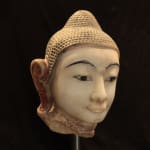Monumental Shan Marble Buddha Head, 18th century CE
Marble
height: 47 cm (18 1/2 in) exclusive of mounting; 65 cm (25 5/8 in) inclusive of mounting
AB.004
Further images
-
(View a larger image of thumbnail 1
)

-
(View a larger image of thumbnail 2
)

-
(View a larger image of thumbnail 3
)

-
(View a larger image of thumbnail 4
)

-
(View a larger image of thumbnail 5
)

-
(View a larger image of thumbnail 6
)

-
(View a larger image of thumbnail 7
)

-
(View a larger image of thumbnail 8
)

-
(View a larger image of thumbnail 9
)

-
(View a larger image of thumbnail 10
)

-
(View a larger image of thumbnail 11
)

-
(View a larger image of thumbnail 12
)

-
(View a larger image of thumbnail 13
)

-
(View a larger image of thumbnail 14
)

-
(View a larger image of thumbnail 15
)

This marble sculpture from Myanmar portrays the Buddha with a peaceful expression, conveyed through his curved eyebrows, downward gaze, and gentle smile. This acts as a reminder of his inner...
This marble sculpture from Myanmar portrays the Buddha with a peaceful expression, conveyed through his curved eyebrows, downward gaze, and gentle smile. This acts as a reminder of his inner serenity, which he achieved through meditation. The dark paint used for the arched eyebrows and to pick out the details of the eyes helps to draw attention to these features, in contrast to the white marble of his skin. His rounded ushnisha (a protuberance on the top of the head which is one of the key characteristics of the Buddha and which symbolises his enlightenment) is covered with tight curls decorated in black and gold lacquer. The ears are painted red, and elongated both upwards and downwards. Within East Asian belief, particularly Buddhism, large ears are seen as a sign of wisdom and compassion. The Buddha is often depicted with elongated ears to symbolise his ability to hear the cries of those who are suffering, and his sympathy and willingness to help ease their pain. It is therefore a comforting image, as it reminds those who see it that there is hope for an end to their sufferings through the search for enlightenment and the compassion of those who have reached it.
The high arched eyebrows and soft smiling expression, as well as the use of marble, are characteristics which suggest that this is a Shan sculpture. The Shan people are an ethnic group that have been living in Myanmar since the 11th century, and are believed to have migrated from Yunnan in China. Today, they are the largest minority group, primarily based in the Shan state in the east of Myanmar, but between the 13th and 16th centuries Shan chiefs ruled much of the country. Their religion is primarily Buddhist, and their culture is closely related to that of Thailand and Laos. Shan Buddha sculptures are characterised by slightly open eyes, with high eyebrows and large foreheads. The marble used for Buddha sculptures in Myanmar often comes from the hill range of Sagyin, a village north of Mandalay. This area is an offshoot of the mountainous Mogok area, known as the “Valley of Rubies” because of the high-quality gemstones that have been found there since ancient times. Rubies are therefore also found in the Sagyin hills among the marble.
The high arched eyebrows and soft smiling expression, as well as the use of marble, are characteristics which suggest that this is a Shan sculpture. The Shan people are an ethnic group that have been living in Myanmar since the 11th century, and are believed to have migrated from Yunnan in China. Today, they are the largest minority group, primarily based in the Shan state in the east of Myanmar, but between the 13th and 16th centuries Shan chiefs ruled much of the country. Their religion is primarily Buddhist, and their culture is closely related to that of Thailand and Laos. Shan Buddha sculptures are characterised by slightly open eyes, with high eyebrows and large foreheads. The marble used for Buddha sculptures in Myanmar often comes from the hill range of Sagyin, a village north of Mandalay. This area is an offshoot of the mountainous Mogok area, known as the “Valley of Rubies” because of the high-quality gemstones that have been found there since ancient times. Rubies are therefore also found in the Sagyin hills among the marble.














